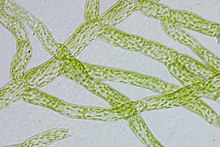Protonema

A protonema (plural: protonemata) is a thread-like chain of cells that forms the earliest stage (the haploid phase) of a bryophyte or pteridophyte life cycle. When a moss first grows from the spore, it grows as a protonema which develops into a leafy gametophore.
Hornworts do not have a protonemal stage, the spores germinate directly into a new Gametophyte generation.
Moss spores germinate to form an alga-like filamentous structure called the protonema. It represents the juvenile gametophyte. While the protonema is growing by apical cell division, at some stage, under the influence of the phytohormone cytokinin, buds are induced which grow by three-faced apical cells. These give rise to gametophores, stems and leaf like structures (bryophytes do not have true leaves (megaphyll). These gametophores are the adult form of the gametophyte.[1] Protonema are characteristic of all mosses and some liverworts but are absent from hornworts. The protonema is also the photosynthetic part of a germinating fern spore.
References
- ^ Ralf Reski (1998): Development, genetics and molecular biology of mosses. Botanica Acta 111, 1-15.
